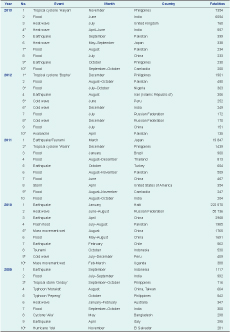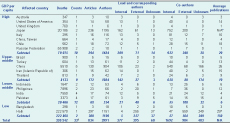
a Office of the WHO Representative in the Philippines, Sta Cruz, Manila, Philippines.
b Office for Technical Services, Department of Health, Sta Cruz, Manila, Philippines.
c Office for Health Regulation, Department of Health, Sta Cruz, Manila, Philippines.
d Health Emergency Management Bureau, Department of Health, Sta Cruz, Manila, Philippines.
e Ateneo School of Medicine and Public Health, Pasig City, Philippines.
Correspondence to Allison Gocotano (email: gocotanoa@ who.int or allisongocotano@gmail.com).
To cite this article:
Gocotano A et al. Can you help me write my story? The institutional affiliations of authors of international journal articles on post-disaster health response. Western Pacific Surveillance and Response Journal, 2015, 6(Suppl 1):10–14. doi:10.5365/wpsar.2015.6.3.HYN_019
Public health policies are, in part, shaped by evidence from peer-reviewed journals. Traditionally these papers have been predominantly written by practitioners with academic affiliations or field-based colleagues wanting to share lessons learnt, including those following disease outbreaks, emergencies or disasters.
Typhoon Haiyan left a corridor of destruction across the Philippines that affected the lives of 16 million people, devastated a health system and challenged every sector of the country.1 The destruction was unprecedented even for one of the world’s most disaster-prone countries. Immediately following Haiyan, the World Health Organization (WHO) Representative Office in the Philippines, together with the Philippine Department of Health (DOH), co-led the health response. DOH and WHO Philippines coordinated more than 150 foreign medical teams2 and more than 500 tonnes of medical supplies and equipment as part of the response. Many lessons were learnt from this experience.
Eighteen months after Haiyan, WHO Representative Office in the Philippines wanted to document some of those lessons and initiated a compendium of papers with the DOH and local government health offices. When conducting literature searches for this process we found many papers were being written by academics, practitioners and responders who were external to the affected country and commonly with little or no involvement of academics, practitioners and responders inside the affected country. A previous study of published articles related to the 15 largest disasters (by number of deaths) over the last decade found that while almost all the disasters occurred in non-Organization for Economic Cooperation and Development (OECD) countries, more than 58% of related publications were led by authors from OECD countries.3
The objective of this paper was to investigate who had published papers about emergencies and disasters (events) in the last five years. This was not intended to be a full systematic review, rather an assessment of the location of authors of papers published on these events.
We used the Annual Disaster Statistical Review from the Centre for Research on the Epidemiology of Disasters to determine the top 10 events per year, based on the number of deaths, from 2009 to 2013 (Table 1).4–8 The countries in which the events took place were classified according to their gross domestic product (GDP) as one of the following: low or low-middle (low) or upper-middle or high (high) income countries.9
Between 15 and 18 May 2015, we conducted a PubMed search using standardized search parameters for health-related peer-reviewed papers published about these events. The search strategy was intended to cover the three humanitarian clusters that form the health response to an event: health (including mental health), nutrition and water, and sanitation and hygiene.10 The search terms were “event type” (e.g. typhoon) AND “country” (e.g. Philippines) AND “year of disaster” (e.g. 2002) AND (medical OR surgical OR disease OR outbreak OR health OR nutrition OR mental OR psychosocial OR sanitation OR hygiene OR drink OR drinking). For weather disturbances such as tropical depressions and cyclones the “event type” was converted into a nested search strategy to include the “international name” (e.g. Haiyan) OR “local name” (e.g. Yolanda) OR “meteorological term” (e.g. tropical cyclone). The search results were refined and only those publications written within three years of the event were included.
Each article was reviewed to ensure it was written post-event. Institutional affiliations for all authors were classified as being internal or external to the affected country based on the location of their affiliation. We separated lead author and coauthors; authors affiliated with institutions and/or organizations with both internal and external locations to the affected country were classified as internal. When we could not determine an author’s affiliation we classified it as unknown. When authorship was collective (e.g. Centers for Disease Control and Prevention) we classified it as external. Affiliation to international organizations including United Nations agencies was also classified as external since we could not determine whether a specific United Nations agency was at the country, regional or global level. It also was not possible to determine if a specific author was a national or an international staff. Assessing the degree of involvement of these institutions in the response was not considered in this classification.
There were no publications for 17 of the 50 events (Table 1); all but three of these (one each for the Russian Federation, Peru and China) were from low-income countries. There were 834 articles published about the other 33 events across 19 countries by 3991 authors. There were 466 papers from 19 events in high-income and 368 papers from 14 events in low-income countries. Overall, there was an average of 25 papers per event, ranging from one for the 2013 United Kingdom heat wave to 297 for the 2010 Haiti earthquake.

* These events had no publications.
The affiliations of lead and corresponding authors were more often internal when the country affected was a high-income country, whereas in low-income countries there were more external authors. This remained when we looked separately at lead/corresponding author and when we included coauthors (Table 2).

* Of the two events in Japan, one generated just one article, while the other had 235 articles.
† 17 events had no publications.
GDP, gross domestic product; and N/A, not applicable.
While more events with high mortality were associated with low-income countries when compared with high-income (87 208 cumulative deaths in high- vs 243 334 in low-income countries) there were fewer publications for the events in low-income countries.
The magnitude of the disaster appeared to influence the number and type of papers published. Those events which had a large humanitarian response resulted in more papers than those managed from the resources within the affected country. The 2010 Haiti earthquake is one such example. There was a considerable international humanitarian presence for the earthquake and 276 publications; the secondary cholera outbreak had 21 publications.
Our study found that most articles on events in low-income countries published in peer-reviewed journals were most commonly written by authors with institutional affiliations external to the country of the event. We also found fewer papers were written about events in low-income countries when compared to high-income countries. This highlights the need for establishing institutional links for capacity and institutional development for scientific writing in low-income countries.
To build capacity in scientific writing to facilitate the publication of the lessons learnt from Haiyan, we partnered with the Western Pacific Surveillance and Response Journal (WPSAR) that offers pre-submission support for first-time authors. This included a five-day workshop on scientific writing with follow-up support for each paper individually. WPSAR then published these articles in this issue. This enabled authors within the Philippines to learn how to write scientific papers and to provide a local perspective for their publications.
Lessons from a highly resourced country on how they responded to an event may not be as helpful to a country with fewer resources as those from a low-income country. We assume that having a better understanding of the context, whether you are an internal or external actor, will likely improve outcomes. Post-event researchers, particularly those reporting from lower-income countries who are external to the affected country, should be strongly encouraged to form proactive collaborations with local researchers.
We acknowledge that there are some limitations in our study. Publications in journals not indexed in PubMed were not included in our study. We also did not search other databases or the wider grey literature. However, as one of the key purposes of publication is for the international community to learn, a non-index journal makes learning from colleagues’ experiences more difficult.
We accept that the results of this study could also be due to several influencing factors. High-income countries are better resourced and are likely to have more institutions capable, interested and resourced to respond and then publish their findings than low-income countries with fewer resources. Institutional incentives to publish, availability of research funding, capability and specific topic or policy interests are all contributing factors. However, there is an ethical, developmental and academic argument for external authors to be more inclusive of internal authors provided that internal institutions are willing to put in the necessary effort required for authorship. It is also likely that events from high-income countries are managed internally hence generating more internal publications. The degree of investment from high-income countries to support response efforts in low-income country events may also influence authorship affiliation.
While GDP will influence available resources, the difference between the number of papers resulting from major events in low- and high-income countries can be possibly explained by other factors. For events in low-income countries – external international support is time-limited and teams leaving the country have to report on their inputs to the government and other donors. This period of reflection and reporting lends itself to publication often done more easily outside the affected country which means those inside the country cannot contribute as easily. Internal players, including those in government, continue responding beyond the initial relief effort through the different phases of the response (recovery, development etc.) and the reflection process may not be prioritized or conducted at all.
Our initial observation tells us that most authors of post-disaster articles were external to the affected country if the disaster was in a low-income country. Increased collaboration between internal and external authors is warranted as are other mechanisms to build capacity in scientific writing, such as collaboration with a peer-reviewed journal. Sharing experiences and lessons learnt are ideally communicated through a collection of views to provide a balanced and more rigorous contribution to the international body of research.
None declared.
None.
This paper was reviewed by Dean Jikyeong Kang of the Asian Institute of Management and Dean Romeo Quizon of the University of the Philippines College of Public Health. The authors acknowledged their support to the key message on increased collaboration between internal and externally affiliated health-related researchers, particularly in a low-income country post-disaster setting for international journal publication.